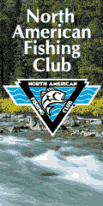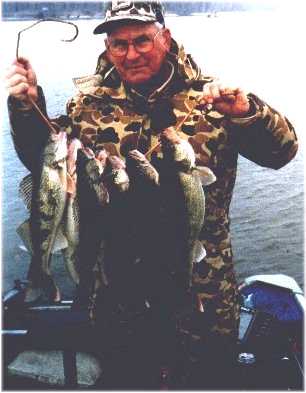
|
|||

Promotional Team Favorites Lodging food and more 
Free 90 day Risk free trial offer click here |
Daniel Vinovich As the falling leaves and cool Indian summer days give way to wet, cold winter winds, river walleye and sauger kick up feeding habits one notch to gain enough weight to make it through the spring spawning runs. If you can withstand the cold temperatures, frozen motors, and your rod guides icing up, this is your best time to put a giant walleye or sauger on the wall. The fish have been feeding hard for 2-3 months. The slender, long sauger and walleye now turn into footballs. An 18 inch fish can now weigh up to 3 lb. When water temperatures start dropping into the mid to low 40’s, another seasonal movement begins. They start moving into the deep, slow moving holes. They don’t move there because it is more comfortable, but to continue feeding. In other words, they follow the shad. Areas below bridges, barge loading facilities, deep, slow bends in the river, and washouts below dams become target areas. Once again, use your maps to locate these areas and your electronics to pinpoint the spot. These fish are generally easy to locate. Work the deep holes slowly with your electronics. When you spot the large clouds of bait fish, start fishing. Most of the time, you won’t be able to spot the sauger and walleye, but believe me, they are under the baitfish just waiting for an easy meal. There are two main presentations I use to reach these deep fish, jigs and 3-way rigs. In other words, get the lead out! With these presentations, you can easily attain any depth you want by just graduating to more lead as you probe deeper to locate fish. Of these two presentations, vertical jigging is probably the best suited for most winter fishing. Vertical jigging is a technique that can be harder than it looks. You shouldn’t have any problems if you use these simple steps. 1. Start upstream 50 to 100 yards of your target area. This will enable you to have control of your boat and jig before you reach the fish. 2. Using your electric motor (I use a 3. Use enough weight to maintain bottom contact. In rivers, if you’re not on the bottom, you’re not in fish. 4. Take plenty of jigs in the boat with you with weights ranging from 1/8 oz. to 1 oz. This will usually cover most river scenarios. Remember, just because you fished yesterday with a 1/4 oz. jig, today could be high winds and more current which could justify the use of 3/4 oz. to 1 oz. in the same area. Rivers change daily. 5. Use smaller diameter lines, such as 4 to 6 lb. test. This will land most of these cold water fish. The thinner diameter will allow you to use less weight and still maintain good bottom contact. The super lines and small diameter mono, such as Silver Thread, work equally well for vertical jigging. 6. Always use a stinger hook in the tail of your minnow.
During this time of year, you don’t always feel the hit so set the
hook when you feel anything different. My choice of stinger
is the Wazp reverse barb stinger. It is a thin wire hook with the
third treble reversed so it stays in the bait firmly. It also
comes with a convenient snap which can be used over and over on any
style jig. The common 3-way rig or modified 3-way rig is my
other choice. A #7 3-way swivel is attached to the main line.
A 6 inch dropper is tied on with a weight. Use enough weight
so you can stay close to the boat and still feel bottom. The
rig is finished with an 18-30 inch snell and a floating jighead or colored
beads with a hook tipped with a big fathead minnow. You can
also use small floating stick baits such as the Excalibur Minnow.
(At 2 1/2 inches, it is an easy target for slow moving walleyes and
sauger.) The modified 3-way rig is another good way to go.
Pick up some
Fish Clix Banner Exchange Please visit these site sponsors |
||
|---|---|---|---|

